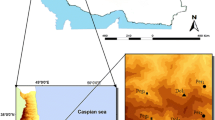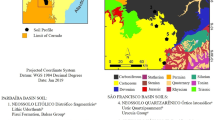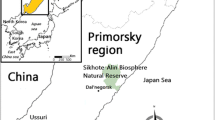Abstract
Increasing demographic pressure in the area around the Mounts Kupe and Manengouba (Cameroon) is leading to increased agricultural activities with potential heavy metal pollution problems. Concentrations of twelve trace elements (TEs) in five Andosols and one Cambisol developed on tephra of ages varying from 6.61 ± 0.17 to 0.01 ± 0.12 Ma of the mounts mentioned above were determined and their correlation relationships with selected soil physico–chemical (organic matter (OM), \({\text{p}}{{{\text{H}}}_{{{{{\text{H}}}_{{\text{2}}}}{\text{O}}}}}\), pHKCl, pHNaF, oxalate extractable Al, Fe, Si, pyrophosphate extractable Al, allophane and ferrihydrite contents) properties evaluated. Alkaline fusion was used to bring the elements in solution followed by elemental detection through ICP–OES. Results showed that average concentrations (ppm) of the TEs increased in the following order: Be, Bi (<5) ≈ Cd, Pb (<10) < Co (54 ± 13), Cu (60 ± 23) < S (109 ± 140), Ni (119 ± 51), Zn (125 ± 17), Cr (152 ± 69), Sr (197 ± 133) < Ba (472 ± 224). Vertical distribution of TEs was irregular, except for S accumulated in topsoil. Ba, Sr, and Zn are associated to OM and allophane according to correlation analysis. Cr, Co, Cu and Ni are apparently more related to OM and pH, while S appears to be related to OM only. In both the Andosols and Cambisol, TEs are dominantly lithogenic. Relationships between TEs indicated that Ba is associated to Zn, Co to Cr, Cu and Ni, Cr to Cu and Ni, while Cu is associated to Ni. Status of TEs in these soils will provide more critical information to environmentalists for pollution monitoring. This study provides baseline data on TE concentrations and distribution in tephra soils of the humid tropics in Africa where a paucity of such data exists.


Similar content being viewed by others
REFERENCES
A. Abd–Elfattah, and K. Wada, “Adsorption of lead, copper, zinc, cobalt and cadmium by soils that differ in cation–exchange materials,” J. Soil Sci. 32, 271–283 (1981). https://doi.org/10.1111/j.1365-2389.1981.tb01706.x
J. Aller, J. L. Bernal, and M. J. Del Nozal, Geochemistry of Trace Elements, Comun. I.N.I.A., Ser.: Prot. Veg. no. 18 (National Institute for Agricultural and Food Research and Technology, Madrid, 1989).
B. J. Alloway, “Sources of heavy metals and metalloids in soils,” in Heavy Metals in Soils: Trace Metals and Metalloids in Soils and their Bioavailability, Ed. by B. J. Alloway (Springer–Verlag, Dordrecht, 2013), pp. 367–394. https://doi.org/10.1007/978-94-007-4470-7
J. V. Amaral, R. T. Cruz, Cunha, and A. Rodrigues, “Baseline levels of metals in volcanic soils of the Azores (Portugal),” Soil Sediment Contam. 15, 123–130 (2006). https://doi.org/10.1080/15320380500506255
T. Asami and F. Fukazawa, “Beryllium contents of uncontaminated soils and sediments in Japan,” Soil Sci. Plant Nutr. 31 (1), 43–53 (1985). https://doi.org/10.1080/17470765.1985.10555216
G. S. Bañuelos and H. A. Ajwa, “Trace elements in soils and plants: an overview,” J. Environ. Sci. Health, Part A 34 (4), 951–974 (1999). https://doi.org/10.1080/10934529909376875
R. J. Bartlett and B. R. James, “Mobility and bioavailability of chromium in soils” in Chromium in Nature and Human Environments, Ed. by J. O. Nriagu and E. Nieboer (Wiley, New York, 1988), pp. 189–216.
G. A. Borchardt and M. E. Harward, “Trace element correlation of volcanic ash soils,” Soil Sci. Soc. Am. Proc. 35, 626–631 (1971). https://doi.org/10.2136/sssaj1971.03615995003500040040x
M. M. S. Cabral Pinto, E. Ferreir da Silva, M. M. V. G. Silva, and P. Melo–Gonçalves, “Heavy metals of Santiago Island (Cape Verde) top soils: estimated background value maps and environmental risk assessment,” J. Afr. Earth Sci. 101, 162–176 (2015). https://doi.org/10.1016/j.jafrearsci.2014.09.011
W. Childs, Towards Understanding Soil Mineralogy: II. Notes on Ferrihydrite: NZ Soil Bureau Laboratory Report CM7 (New Zealand Soil Bureau, Lower Hutt, NZ, 1985).
E. Davies, Applied Soil Trace Elements (Wiley, Chichester, 1980).
N. Defarge, J. Spiroux de Vendômois, and G. E. Séralini, “Toxicity of formulants and heavy metals in glyphosate–based herbicides and other pesticides,” Toxicol. Rep. 5, 156–163 (2018). https://doi.org/10.1016/j.toxrep.2017.12.025
P. Devendar and G. Yang, “Sulfur–containing agrochemicals,” Top. Curr. Chem. 375 (82), 1–44 (2017). https://doi.org/10.1007/s41061-017-0169-9
E. Dœlsch, V. van de Kerchove, and H. S. Macary, “Heavy metal content in soils of Réunion (Indian Ocean),” Geoderma 134, 119–134 (2006). https://doi.org/10.1016/j.geoderma.2005.09.003
R. K. Enang, B. P. K. Yerima, G. K. Kome, and E. van Ranst, “Effects of forest clearance and cultivation on bulk density variations and relationships with texture and organic matter in tephra soils of Mount Kupe (Cameroon),” Commun. Soil Sci. Plant Anal. 48 (19), 2231–2245 (2017). https://doi.org/10.1080/00103624.2017.1407785
R. K. Enang, B. P. K. Yerima, and G. K. Kome, “Soil physico–chemical properties and land suitability evaluation for maize (Zea mays), beans (Phaseolus vulgaris) and Irish potatoes (Solanum tuberosum) in tephra soils of the western slopes of Mount Kupe (Cameroon),” Afr. J. Agric. Res. 11 (45), 4571–4583 (2016). https://doi.org/10.5897/AJAR2016.11669
European Commission, Directive 2003/17/EC of the European Parliament and of the Council of March 3, 2003 Amending Directive 98/70/EC Relating to the Quality of Petrol and Diesel Fuels (Brussels, 2003).
A. B. Fabricio Neta, C. W. A. do Nascimento, C. M. Biondi, P. van Straaten, and S. M. B. Bittar, “Natural concentrations and reference values for trace elements in soils of a tropical volcanic archipelago,” Environ. Geochem. Health 40 (1), 163–173 (2016). https://doi.org/10.1007/s10653-016-9890-5
Guidelines for Soil Description, 4th ed. (UN Food and Agriculture Organization, Rome, 2006).
B. Gèze, Géographie Physique et Géologie du Cameroun Occidental, Mémoires du Muséum National d’Histoire Naturelle, Nouv. Sér. 17 (Éditions du Muséum, Paris, 1943).
W. L. Griffin, B. Sundvoll, and H. Kristmannsdottir, “Trace element composition of anorthosite plagioclase,” Earth Planet. Sci. Lett. 24, 213–223 (1974). https://doi.org/10.1016/0012-821X(74)90099-5
K. S. Heier and S. R. Taylor, “Distribution of Ca, Sr and Ba in southern Norwegian pre–Cambrian alkali feldspars,” Geochim. Cosmochim. Acta 17, 286–304 (1959). https://doi.org/10.1016/0016-7037(59)90101-2
ISO 14869–2:2002: Soil Quality—Dissolution for the Determination of Total Element Content—Part 2: Dissolution by Alkaline Fusion (International Organization for Standardization, Geneva, 2002).
IUSS Working Group WRB, World Reference Base for Soil Resources 2014, Update 2015, International Soil Classification System for Naming Soils and Creating Legends for Soil Maps, World Soil Resources Reports No. 106 (UN Food and Agriculture Organization, Rome, 2015).
A. Kabata–Pendias, Trace Elements in Soils and Plants, 4th ed. (CRC Press, Boca Raton, FL, 2011). https://doi.org/10.1201/b10158
M. Kaur, Bachelor’s Theses (Claremont, CA, 2013). http://scholarship.claremont.edu/scripps_theses/150.
C. Latrille, L. Denaix, and I. Lamy, “Interaction of copper and zinc with allophane and organic matter in the B horizon of an andosol,” Eur. J. Soil Sci. 54, 357–364 (2003). https://doi.org/10.1046/j.1365-2389.2003.00530.x
V. E. Manga, C. M. Agyingi, and C. E. Suh, “Trace element soil quality status of mount Cameroon soils,” Adv. Geol. 2014, 1–8 (2014). https://doi.org/10.1155/2014/894103
M. Marks, R. Halama, T. Wenzel, and G. Markl, “Trace element variations in clinopyroxene and amphibole from alkaline to peralkaline syenites and granites: implications for mineral–melt trace–element partitioning,” Chem. Geol. 211, 185–215 (2004). https://doi.org/10.1016/j.chemgeo.2004.06.032
V. Mendoza–Grimón, J. M. Hernández–Moreno, J. A. Rodríguez Martín, J. R. Fernández–Vera, and M. P. Palacios–Díaz, “Trace and major element associations in basaltic ash soils of El Hierro Island,” J. Geochem. Explor. 147, 277–282 (2014). https://doi.org/10.1016/j.gexplo.2014.06.010
W. E. Motzer, “Chemistry, geochemistry, and geology of chromium and chromium compounds,” in Chromium (VI) Handbook, Ed. by J. Guertin, J. A. Jacobs, and C. P. Avakian (CRC Press, Boca Raton, FL, 2005), pp. 23–91. https://doi.org/10.1201/9780203487969.ch2
G. Nkouathio, D. A. Kagou, J. M. Bardintzeff, P. Wandji, H. Bellon, and A. Pouclet, “Evolution of volcanism in graben and horst structures along the Cenozoic Cameroon Line (Africa): implications for tectonic evolution and mantle source composition,” Miner. Petrol. 94, 287–303. https://doi.org/10.1007/s00710-008-0018-1
M. Norman, M. O. Garcia, and A. J. Pietruszka, “Trace–element distribution coefficients for pyroxenes, plagioclase, and olivine in evolved tholeites from the 1955 eruption of Kilauea Volcano, Hawaiʼi, and petrogenesis of differentiated rift–zone lavas,” Am. Miner. 90, 888–899 (2005). https://doi.org/10.2138/am.2005.1780
R. L. Parfitt, and A. D. Wilson, “Estimation of allophane and halloysite in three sequences of volcanic soils,” in Volcanic Soils: Weathering and Landscape Relationships of Soils on Tephra and Basalt, Catena Supplement vol. 7, Ed. by E. Fernandez–Caldos, and D. H. Yaalon (Catena, Cremlingen, 1985), pp. 1–8.
J. M. Pauwels, E. van Ranst, M. Verloo, and A. Mvondo Ze, Manuel de Laboratoire de Pédologie—Méthodes d’Analyses de Sols et de Plantes; Équipment et Gestion des Stocks de Verrerie et de Produits Chimiques, Publications Agricoles no. 28 (Administration Generale de la Cooperation au Development, Brussels, 1992).
M. J. Plantinga, Redistribution of Trace Elements upon the Weathering of Volcanic Ash Soils in Costa Rica: Report No. 119 (Agriculture University of Wageningen, Wageningen, 1997).
A. Pouclet, D. A. Kagou, J. M. Bardintzeff, P. Wandji, T. P. Chakam, D. G. Nkouathio, H. Bellon, and G. Ruffet, “The Mount Manengouba, a complex volcano of the Cameroon Line: Volcanic history, petrological and geochemical features,” J. Afr. Earth Sci. 97, 297–321 (2014). https://doi.org/10.1016/j.jafrearsci.2014.04.023
S. Rahman, H. Takaki, M. Tamai, and Y. Nagatomo, “Distribution of zinc, manganese, copper, cobalt, and nickel in andosols profiles,” Soil Sci. Plant Nutr. 42 (4), 881–891 (1996). https://doi.org/10.1080/00380768.1996.10416635
C. Reimann and P. de Caritat, Chemical Elements in the Environment: Factsheets for the Geochemist and Environmental Scientist (Springer–Verlag, Berlin, 1998).
H. R. Rollinson, Using Geochemical Data: Evaluation, Presentation, Interpretation (Prentice Hall, New York, 1993).
W. H. Schlesinger and E. S. Bernhardt, Biogeochemistry: An Analysis of Global Change (Academic, San Diego, 2013).
A. W. Schroth, B. C. Bostick, M. Graham, J. M. Kaste, M. J. Mitchell, and A. J. Friedland, “Sulfur species behavior in soil organic matter during decomposition,” J. Geophys. Res.: Biogeosci. 112, 1–10 (2007). https://doi.org/10.1029/2007JG000538
R. Schulin, A. Johnson, and E. Frossard, “Trace element–deficient soils,” in Trace Elements in Soils, Ed. by P. S. Hooder (Blackwell, Oxford, 2010), pp. 175–194. https://doi.org/10.1002/9781444319477.ch9
E. Schulte, Understanding plant nutrients, soil and applied Zn. http://learningstore.uwex.edu/Assets/pdfs/ A2528.pdf (2004).
C. M. Scott, “Background metal concentration in soils in northern Santa Clara County, California,” in Recent Geologic Studies in the San Francisco Bay Area, Ed. by E. M. Sanginés, D. W. Anderson, and A. V. Buising (Pacific Section Society for Sedimentary Geology, Los Angeles, CA, 1995), Vol. 76, pp. 217–224.
S. Shoji, M. Nanzyo, and R. A. Dahlgren, Volcanic Ash Soils, Genesis, Properties and Utilization, Developments in Soil Science no. 21 (Elsevier, Amsterdam, 1993).
Soil Survey Staff, Soil Survey Laboratory Methods Manual. Procedures for Collecting Soil Samples and Methods of Analysis for Soil Survey, Version 3.0, Soil Survey Investigation Report no. 42, (US Department of Agriculture, Washington, DC, 1996).
A. Soukoup, B. J. Buck, and W. Harris, “Preparing soils for mineralogical analyses,” in Methods of Soil Analysis, Part 5: Mineralogical Methods, SSSA Book Series no. 5, Ed. by A. L. Ulery and L. R. Drees (Soil Science Society of America, Madison, WI, 2008), pp. 13–31. https://doi.org/10.2136/sssabookser5.5.c2
A. Takeda, K. Kimura, and S. I. Yamasaki, “Analysis of 57 elements in Japanese soils, with special reference to soil group, and agricultural use,” Geoderma 119, 291–307 (2004). https://doi.org/10.1016/j.geoderma.2003.08.006
S. M. Testa, “Sources of chromium contamination in soil and groundwater,” in Chromium (VI) Handbook, Ed. by J. Guertin, J. A. Jacobs, and C. P. Avakian (CRC Press, Boca Raton, FL, 2005), pp. 144–163. https://doi.org/10.1201/9780203487969.ch4
B. P. K. Yerima and E. van Ranst, Major Soil Classification Systems Used in the Tropics: Soils of Cameroon (Trafford, Victoria, BC, 2005).
B. P. K. Yerima, E. van Ranst, S. Sertsu, and A. Verdoodt, “Pedogenic impacts on the distribution of total and available Fe, Mn, Cu, Zn, Cd, Pb and Co contents of Vertisols and vertic Inceptisols of the Bale Mountain area of Ethiopia,” Afr. J. Agric. Res. 8 (44), 5429–5439 (2013). https://doi.org/10.5897/AJAR09.188
Author information
Authors and Affiliations
Corresponding author
Ethics declarations
The authors declare that they have no conflict of interest.
Supplementary material
Rights and permissions
About this article
Cite this article
Roger Kogge Enang, Bernard Palmer Kfuban Yerima, Georges Kogge Kome et al. Trace Elements in Tephra Soils of Mounts Kupe and Manengouba (Cameroon). Eurasian Soil Sc. 53, 595–606 (2020). https://doi.org/10.1134/S1064229320050051
Received:
Revised:
Accepted:
Published:
Issue Date:
DOI: https://doi.org/10.1134/S1064229320050051




